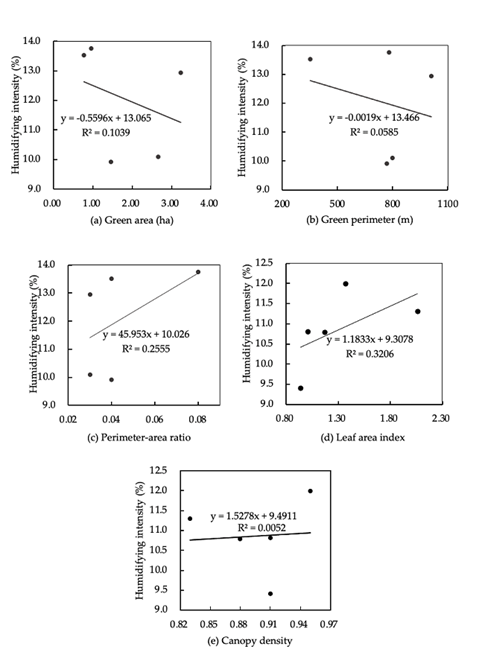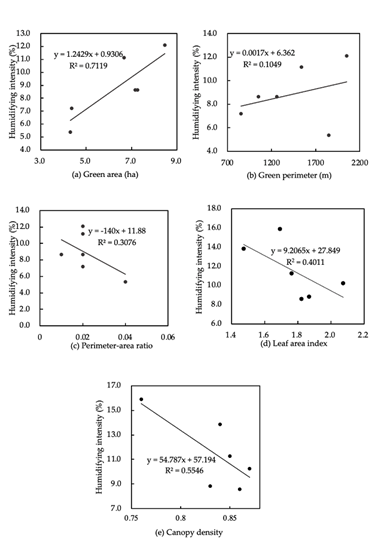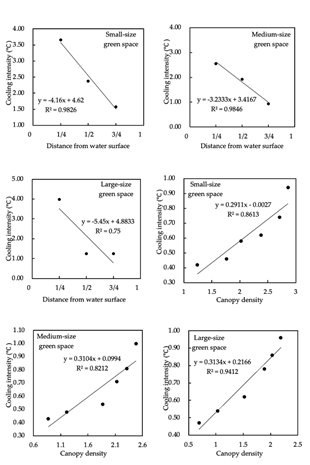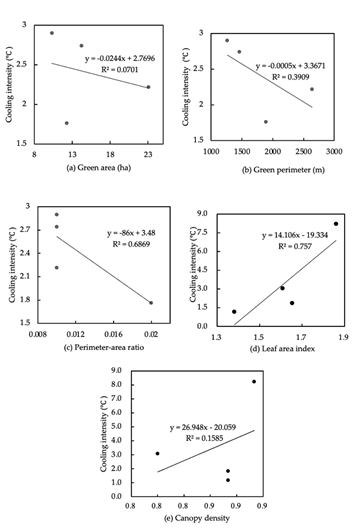January 27, 2022 at 9:14 pm | Updated March 16, 2022 at 12:38 pm | 6 min read
In this sub-tropical research study, scientists examined the area and shape of parks, leaf area index, canopy density, and proximity to bodies of water. The study found one feature, above others, to be decisive in the cooling of urban spaces. Let’s dive in and explore their findings.
The Experiment

Suzhou Industrial Park, the site chosen for the experiment, was 200 km away from the ocean and 20 km from the nearest lakes, so any cooling and humidifying was assumed to come from local water bodies and green spaces.
This area has a subtropical maritime monsoon climate, and the experiment was conducted in summer. With the help of aerial drone photography, the researchers selected 15 green spaces, see Figure 1.
Subscribe to the CID Bio-Science Weekly article series.
By submitting this form, you are consenting to receive marketing emails from: . You can revoke your consent to receive emails at any time by using the SafeUnsubscribe® link, found at the bottom of every email. Emails are serviced by Constant Contact
Areas below 4ha were called small spaces, areas between 4-10ha were considered medium-sized spaces, and areas of more than 10ha were designated as large green spaces. Based on tree density, the researchers classified green spaces as sparse (canopy density of 0.4-0.6), dense (canopy density of 0.7-1.0), and others.
The scientists also classified the green spaces based on the ratio of their area to their distance from the nearest local water bodies. This ratio they categorized as short, medium, and long distanced. So, for example, a 50m green space that is 200m away from the nearest body of water has a ratio of ¼ and is said to be at a short distance—similarly, an area-distance ratio of ½ defined medium-distance, and a ratio of ¾ long-distance.
Moreover, three shapes of water bodies of increasing size were also considered- banded, massive, and annular, see Figure 2.

Weather parameters were measured 1.5 m above ground every 10 seconds between 10:00 and 16:00 hours at three places in each site and three control points 100 m away to record changes in microclimate. The temperature and humidity were averaged for each hour.
The researchers used the CI-110 Plant Canopy Imager, produced by CID Bio Science, Inc. to estimate the leaf area index. The tool uses the Gap Fraction Method to calculate leaf area index. The calculation is based on the amount of sky that is visible from below the plant canopy and does not require an above-canopy measurement.
The effects of five characteristics – area, perimeter, perimeter-area ratio, canopy density, and leaf area index– were studied and correlated with temperature and humidity using multiple regression models.
The scientists then used the results in a simulation to study the effects of increasing water body area on cooling and humidification.
Bigger is Not Always Better

The scientists found that the cooling and humidifying effects do not increase with the size of the green spaces, see Figure 3a. Moreover, the cooling and humidifying effects varied at different hours.
The small-sized plots significantly impact temperature and humidity, even though they experience greater daily temperature fluctuations than large-sized green spaces. The medium-sized green spaces had the maximum cooling and humidifying effects of all three sizes, see Figure 4.

Perimeter-Area Ratio
As the perimeter-area ratio decreased, the cooling efficiency increased. A round shape is more stable and effective in blocking solar radiation, so the cooling and humidifying effects are greater.
Leaf Area Index
This study found only a weak correlation between the leaf area index and cooling intensity. An increase in leaf area index by 0.1 increased the cooling intensity by 0.11℃.
Canopy Density
An increase in canopy density produced more significant cooling than LAI, but again depended on the size of the green space, see Figure 3e.
Thus every 0.5 increase in canopy density, increased cooling by
- 0.16℃ in large and medium green spaces, and
- 0.15℃ in small-sized spaces.

Water Bodies and Their Distance to Green Spaces
The distance of parks from water bodies was also significant. Green spaces closer to water bodies are cooler and more humid, regardless of their size, see Figure 5. Moreover, there is an interaction between the area of a green space and its distance to water bodies.
For every ¼ increase in distance ratio,
- In medium-sized green spaces, the cooling effect decreased by 0.81℃ and humidity effects by 3.02%,
- In small green spaces, cooling effects fell by 1.04℃ and humidification by 4.23%, and
- In large green spaces, cooling effects were reduced by 1.36℃ and the humidifying intensity by 6.14%.
The shape and size of the water body can also be crucial. The cooling and humidification effects were most significant in annular, followed by massive, and then banded water bodies. For an increase of 5% in the area of the water bodies,
- In annular water bodies, there was an increase in cooling effect by 0.07℃ and in the humidifying effect by 0.21%
- In massive water bodies, the increase in cooling effect was by 0.04℃ and the humidifying effect by 0.08%, and
- In banded water bodies, the increase in cooling effect was by 0.02℃ and the humidifying effect by 0.05%.
The scientists suggest that the presence of a water body in green spaces increases the cooling and humidifying effect, as the water’s thermal absorption is greater and reflectivity is lower than land.
Collective Effect

Though the effect of leaf area index, canopy density, and plant density increased alongside green space area, the influence of each parameter varied depending on the size of the park.
- For small spaces, the effect of canopy density on cooling was most significant. The leaf area index, canopy density, area, and perimeter-to-area ratio explained 59.3% of the cooling and 61.2% of the humidifying effects.
- In medium-sized green spaces, the correlation was most significant when taking into account the area and perimeter-to-area ratio. While the humidifying effect depended only on the area. Around 70.7% of the cooling effect and 71.1% of the humidifying effect were explained by park area, perimeter-area ratio, canopy density, and leaf area index.
- Large-sized green spaces’ cooling effect was dependent on leaf area index and perimeter-area ratio, while the humidifying effect was determined by canopy density, see Figure 6. The three parameters, leaf area index, perimeter-area ratio, and canopy density, explained 55.8% of the cooling and 51.3% of the humidifying effects.
Collectively, the area of green spaces, perimeter-to area ratio (shape), leaf area index, and canopy density explained 61.9% of the cooling effects and 61.2% of the humidifying effects. However, other factors like the type of soil, presence of pavements, type of land use, and type of external urban environment will also influence the extent to which green spaces can cool down and humidify the urban environments in which they reside.
Important Green Space Parameters
The size of the green spaces like parks is at the top of the list of important factors. Most scientific findings suggest that the larger the park, the higher is its ability to cool its surroundings. However, a few studies disagree.
Then there is the humidifying effect of green spaces. It can be more when the green space is a woodland than when it is a park. The presence of water bodies, like ponds and streams, also add to the humidifying effect by themselves or in combination with green spaces.
The tree composition of green spaces whether they are parks or woodlands can also influence temperature because differences in the canopy will change rainfall interception and water uptake.
If the elements of the landscapes and their factors that produce the most cooling and humidifying effects are identified, they can be integrated into city and town planning to reduce the urban heat island effects.
Designing Future Parks
When designing parks in sub-tropical regions, the scientists recommend medium-sized parks between 4-10 ha. They also recommend that the parks are round or rectangle in shape to get the best cooling and humidifying effects. Moreover, including large water bodies, increasing the number of trees, mixing trees and pavements can enhance the cooling and humidifying effects of parks and woodlands in an urban area and help in alleviating urban heat islands. This can go a long way in making cities sustainable by reducing the amount of energy used in cooling buildings
—
Vijayalaxmi Kinhal
Science Writer, CID Bio-Science
Ph.D. Ecology and Environmental Science, B.Sc Agriculture
Source
Xiao, X., Zhang, L. & Xiong, Y. (2021). Influence of Spatial Characteristics of Green Spaces
on Microclimate: A Case Study in Suzhou Industrial Park, China. Research Square. Preprint. DOI:
10.21203/rs.3.rs-591707/v1
Related Products
Most Popular Articles
- Transpiration in Plants: Its Importance and Applications
- Leaf Area – How & Why Measuring Leaf Area…
- How to Analyze Photosynthesis in Plants: Methods and Tools
- Plant Respiration: Its Importance and Applications
- The Forest Canopy: Structure, Roles & Measurement
- Stomatal Conductance: Functions, Measurement, and…
- Forest & Plant Canopy Analysis – Tools…
- Root Respiration: Importance and Applications
- The Importance of Leaf Area Index (LAI) in…
- Irrigating with Saline or Seawater






